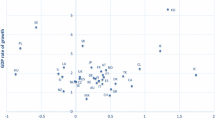Abstract
Using a standard endogenous growth model with public capital accumulation enriched with tax evasion (Roubini and Sala-i-Martin in J Monet Econ 35:275–301, 1995) developed by Kafkalas et al. (Eur Econ Rev 70:438–453, 2014), we provide empirical evidence on the relationship between aggregate output growth, announced tax rate and tax monitoring expenses for a set of 32 OECD countries during the 2000–2007 period. Our results indicate that high announced tax rates above the elasticity of public capital and excess expenses on tax auditing as means of reducing tax evasion are not effective deepening the recession.
Similar content being viewed by others
Notes
For more details on model description along with its solution see Kafkalas et al. (2014).
For presentation purposes, we name these groups as: lower income group, low-middle income group, high-middle income group and higher income group.
We have also tried to include a multilateral structure for monitoring expenses in the tax evasion function, but our data failed to support such type of heterogeneity. It is likely that the inclusion of education in the tax evasion function absorbs part of the heterogenous effects of monitoring expenses on tax evasion. Based on these results, the impact of tax monitoring expenses on effective tax rate was assumed to be homogenous across countries.
All series were statistically tested for stationarity using Pesaran (2007) panel unit root test for heterogenous panels with cross section dependence. The null hypothesis of a unit root was rejected for all series at least at the 10 percent significance level, indicating stationary series.
Since data on educational attainment are available only in 5-year intervals, while the rest of our data are on annual basis, we have assumed a constant annual growth rate for education within each interval.
Given that the true direct impact of z and \(\mu \) on growth is nonlinear and the values of the two variables are ranging in different intervals, the assumed linear effects as captured by the corresponding coefficients cannot provide a proper measurement of their impact on growth neither in relative nor in absolute terms. To deal with the first issue, we used the z-score method to normalize the z and \(\mu \) variables in (4) which enables the direct comparison of their impact on growth. Alternatively, we could simply assume a nonlinear specification for \(\mu \) and z variables in (4) which would potentially deal with both issues. However, we believe that such an arrangement would detract out of the purpose of this study which is mainly on the indirect effect of \(\mu \) and \(\tau \).
Education variable was normalized to the sample mean.
References
Barro R (1990) Government spending in a simple model of endogenous growth. J Polit Econ (supplement, Part II):S103–S125
Barro R, Lee JW (2010) A new data set of educational attainment in the world, 1950–2010. NBER working paper no. 15902. Version 2.1. http://www.barrolee.com
Chatzimichael K, Tzouvelekas V (2014) Human capital contributions to explain productivity differences. J Product Anal 41:399–417
Engstrom P, Holmlund B (2009) Tax evasion and self-employment in a high-tax country: evidence from Sweden. Appl Econ 41:2419–30
Frey B, Weck-Hannemann H (1984) A hidden economy as an unobserved variable. Eur Econ Rev 26:33–53
Giles D (1999) Measuring the hidden economy: implications for econometric modelling. Econ J 109:370–380
Gilman M, Kejak M (2014) Tax evasion, human capital, and productivity-induced tax rate reduction. J Hum Cap 8:42–79
Jorgenson DW, Nishimizu M (1978) US and Japanese economic growth, 1952–1974: an international comparison. Econ J 88:707–726
Kafkalas I, Kalaitzidakis P, Tzouvelekas V (2014) Tax evasion and public expenditures on tax revenue services in an endogenous growth model. Eur Econ Rev 70:438–453
Lago-Peñas I, Lago-Peñas S (2010) The determinants of tax morale in comparative perspective: evidence from European countries. Eur J Polit Econ 26:441–453
OECD (2002) Measuring the non-observed economy: a handbook, international labour Office/International Monetary Fund/International Statistical Committee of the Common wealth of independent States/OECD Publishing. http://www.oecd.org/sdd/na/1963116.pdf. Accessed 16 June 2017
Pesaran HM (2007) A simple panel unit root test in the presence of cross-section dependence. J Appl Econom 22:265–312
Roubini N, Sala-i-Martin X (1995) A growth model of inflation, tax evasion, and financial repression. J Monet Econ 35:275–301
Sandmo A (2005) The theory of tax evasion: a retrospective view. Natl Tax J 4:643–663
Schneider F, Buehn A, Montenegro CE (2010) Shadow economies all over the world: new estimates for 162 Countries from 1999 to 2007 (revised version). Policy research working paper 5356, The World Bank, Development Research Group. http://documents.worldbank.org/curated/en/311991468037132740/pdf/WPS5356.pdf. Accessed 16 June 2014
Simar L (2003) Detecting outliers in frontier models: a simple approach. J Product Anal 20:391–424
Slemrod J, Yitzhaki S (2002) Tax avoidance, evasion and administration. In: Auerbach AJ, Feldstein M (eds) Handbook of public economics, vol 3. Elsevier, New York, pp 1423–70
Author information
Authors and Affiliations
Corresponding author
Rights and permissions
About this article
Cite this article
Chatzimichael, K., Kalaitzidakis, P. & Tzouvelekas, V. Tax evasion, tax monitoring expenses and economic growth: an empirical analysis in OECD countries. Empir Econ 57, 285–300 (2019). https://doi.org/10.1007/s00181-018-1441-8
Received:
Accepted:
Published:
Issue Date:
DOI: https://doi.org/10.1007/s00181-018-1441-8




